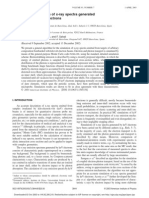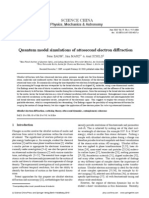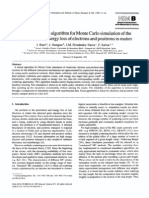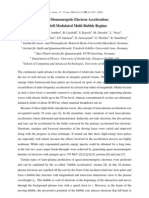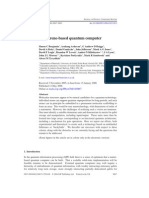Estimates of SEU For Semiconductors Using MC50 Cyclotron and GEANT4 Simulation
Estimates of SEU For Semiconductors Using MC50 Cyclotron and GEANT4 Simulation
Uploaded by
Nguyễn Thành CôngCopyright:
Available Formats
Estimates of SEU For Semiconductors Using MC50 Cyclotron and GEANT4 Simulation
Estimates of SEU For Semiconductors Using MC50 Cyclotron and GEANT4 Simulation
Uploaded by
Nguyễn Thành CôngOriginal Title
Copyright
Available Formats
Share this document
Did you find this document useful?
Is this content inappropriate?
Copyright:
Available Formats
Estimates of SEU For Semiconductors Using MC50 Cyclotron and GEANT4 Simulation
Estimates of SEU For Semiconductors Using MC50 Cyclotron and GEANT4 Simulation
Uploaded by
Nguyễn Thành CôngCopyright:
Available Formats
Journal of the Korean Physical Society, Vol. 59, No. 2, August 2011, pp.
20222025
Estimates of SEU for Semiconductors Using MC50 Cyclotron and GEANT4
Simulation
J. W. Shin
Department of Physics, Sungkyunkwan University, Suwon 440-746, Korea
T. -S. Park and S. W. Hong
Department of Physics and Department of Energy Science,
Sungkyunkwan University, Suwon 440-746, Korea
J. K. Park and J. T. Kim
School of Information and Communication Engineering,
Sungkyunkwan University, Suwon 440-746, Korea
J. -S. Chai
Department of Energy Science and School of Information and Communication Engineering,
Sungkyunkwan University, Suwon 440-746, Korea
(Received 26 April 2010)
The Single Event Upset (SEU) on semiconductor RAM memories due to terrestrial neutrons is
measured by using the MC50 Cyclotron at KIRAMS. Proton beams impinging on a thick Be target
produce neutrons, which then bombard the semiconductors to cause SEU. Due to the thickness of
the Be target used in this experiment, the neutron beam has a broad energy spectrum. Thus, the
SEU could not be obtained directly as a function of neutron energies. To solve this problem, we
propose an approximate method of estimating the SEU as a function of the neutron energy when
the neutron beams have a broad range of energy. In this work, three different energies of proton
beams of 30, 35, and 40 MeV were used. By extracting the difference of the neutron yields at these
energies, we can make a rough estimate of SEU as a function of neutron energies. Monte Carlo
simulations are performed to obtain the neutron flux from the MC50 cyclotron. Our results for the
SEU turn out to be comparable to the previous results.
PACS numbers: 61.80.Hg, 29.20.Hm
Keywords: SEU, MC-50, Neutron, Monte Carlo simulation, GEANT4
DOI: 10.3938/jkps.59.2022
I. INTRODUCTION
Random access memories (RAMs) are sensitive to
high-energy particles such as energetic neutrons in the
atmosphere. The excessive charges generated by high
energy particles incident on reverse-biased PN junctions
can induce an instant current flow which may disrupt
normal system function [1]. This single-event effect
(SEE) can change the content of the memory elements,
which is called Single Event Upset (SEU). In our previous work, we proposed an approximate subtraction
method to take into account the non-mono energetic
nature of the neutron beam from MC-50 cyclotron at
KIRAMS (Korea Institute of Radiological Medical Sciences) [2], where we calculated neutron spectra with
GEANT4 (v.9.1) with G4binary cascade model and ob E-mail:
swhong@skku.ac.kr
tained good results. In this work, we further develop
our approach by first confirming our previous results in
Ref. 2 with an updated version of GEANT4 (v.9.3) and
by checking the dependency of the results with three
different models; Binary Cascade, Bertini Cascade and
LEProtonInelastic models.
II. METHOD
1. SEU cross section
The SEU cross section SEU is defined as
SEU (E) =
1
dNSEU (E)
Nbits dF Ln (E)
(1)
where NSEU (E) denotes the number of SEUs, Nbits the
number of total memory bits, and FLn (E) the neutron
fluence for a given testing time in units of n/cm2 .
-2022-
Estimates of SEU for Semiconductors Using MC50 Cyclotron and GEANT4 Simulation J. W. Shin et al.
Fig. 1. (Color online) The exterior view of the neutron
production target area of MC50 cyclotron.
-2023-
in C++ language, which enables the simulation of propagation of particles that interact with materials and/or
other particles. It is widely used in many different fields
such as high energy and nuclear physics [4-5], medical
physics [6-7] and space science [7-8].
A simulation of the electromagnetic processes is well
standardized, since the underlying theories (i.e., Classical and Quantum Electrodynamics) are well established.
On the contrary, there is a huge diversity for the hadronic
processes, depending on the particles under consideration and on their energies. To accommodate this diversity, many packages (or physics models) are builtin in GEANT4. Users should then invoke the relevant
physics models suitable for the process [9-10], which we
will briefly discuss in the next subsection. In this work,
GEANT4 9.3 version is used.
4. Hadronic Models in GEANT4
Fig. 2. (Color online) Schematic drawing of the neutron
production target area including collimators.
2. Neutron production target of MC-50
Figures 1 and 2 show the target area for producing
neutron beams of the MC-50 cyclotron. The MC-50 cyclotron can provide neutron beams up to 40 MeV generated by the proton beams impinging on the Beryllium
target. The MC-50 cyclotron uses a thick Be target of
10.5 mm in thickness. Due to the thickness of the target, the produced neutrons do not have a narrow peak in
energy but have a broad energy spectrum from 0 to the
incident proton energy. Thus from these neutron beams
we cannot extract the SEU cross section as a function of
the neutron energy. In Ref. 2 we proposed an approximate method of extracting the SEU cross section when
neutrons are produced with a broad energy spectrum by
a thick target. The detailed approximation procedure
can be found in Ref. 2.
To extract the SEU cross section of Eq. (1) one needs
to know the neutron flux that causes the SEU. However,
the experimental data of the neutron beam spectrum for
the present experimental set-up are not available. Thus
we perform GEANT4 Monte Carlo simulation to extract
the neutron beam profile by using the geometry shown
in Fig. 1.
3. GEANT4
GEANT4 (GEometry ANd Tracking 4) [3] is an
object-oriented Monte Carlo simulation toolkit written
In GEANT4, users must choose a proper process for
simulations. In this work we choose three different
hadronic models: Binary Cascade, Bertini Cascade and
LEProtonInelastic.
GEANT4 Binary Cascade is a data driven intranuclear cascade model propagating primary and secondary particles in a nucleus. This model generates the
final state for hadron inelastic scattering by simulating
the intra-nuclear cascade. The target nucleus is modeled
by a 3-D collection of nucleons, as opposed to a smooth
nuclear medium.
The Bertini model also generates the final state for
hadron inelastic scattering by simulating the intranuclear cascade. The final state of each collision is sampled according to free-particle cross section data. The
target nucleus is treated as an average nuclear medium
to which excitons (particle-hole states) are added after
each collision.
LEProtonInelastic model generates the final state for
proton inelastic scattering. It is one of the LEP models
derived from the low energy part of GEISHA [11], which
is parametrisation driven model.
In this work, we used these hadronic models to compare the prediction capabilities of the proton-induced
neutron spallation process.
III. RESULTS
1. Neutron energy spectra
Neutron energy spectra produced by protons of 2 A
from MC-50 cyclotron are calculated with GEANT4 and
are plotted in Fig. 3. Three different hadronic models
are used. In order to obtain the whole neutron spectra, neutron tracking cut was not used. Figure 3 shows
dF Ln /dEn which is the number of neutrons per cm2 as
a function of neutron energy. The dF Ln /dEn is plotted
for three different hadronic models for three incident proton energies. Ep and En denote the incident proton and
-2024-
Journal of the Korean Physical Society, Vol. 59, No. 2, August 2011
Table 1. SEU cross sections ( 1014 ) [cm2 /bit].
6
10
= 30 MeV
G4LE
( n / cm / MeV )
G4Binary
10
En
G4Berti
6
10
= 35 MeV
Previous
results [2]
= 40 MeV
32.5
1.83 0.72
1.99 0.81
1.51 0.79
1.79 0.88
37.5
2.77 1.12
2.84 1.17
2.62 1.15
2.48 1.20
32.5
3.97 0.59
4.24 0.79
3.50 0.69
4.00 0.76
37.5
4.88 0.91
5.01 0.95
4.50 0.82
4.35 1.03
(MeV)
10
10
10
dFL /dE
G4LE
G4Binary
G4Bertini
10
SRAM0
10
10
10
15
20
25
30
35
40
45
(MeV)
Fig. 3. (Color online) Neutron energy spectra produced by
2 A protons of MC-50 cyclotron are simulated for Ep = 30,
35 and 40 MeV.
x 10
difference spectrum
(a)
SRAM1
G4LE
G4Binary
G4Berti
0
9
(b)
10
15
20
25
30
35
40
45
(MeV)
Fig. 4.
(Color online) Difference spectra between two neutron fluencies are plotted.
(a) represents the difference spectra of (dF Ln /dEn )Ep = 35 MeV (dF Ln /dEn )Ep = 30 MeV and (b) represents the difference
spectra of (dF Ln /dEn )Ep = 40 MeV - (dF Ln /dEn )Ep = 35 MeV .
the produced neutron energies, respectively. For neutron
energies higher than about 10 MeV the neutron spectra
obtained from three different models are more or less the
same. However, at neutron energies below 1 MeV, the
LEProtonInelastic (LE) model predicted more yields
than the other two models. On the contrary, neutron
fluences calculated by three different models are almost
the same near the maximum neutron energies. In Eq.
(1) the SEU is defined as a function of neutron energy.
Therefore, to obtain the experimental values of SEU, one
needs the neutron beams in mono energetic form. However, the MC-50 cyclotron produces the neutrons of a
broad range of energy as shown in Fig. 3. With these
broad energy spectra, it is impossible to obtain the SEU
as a function of En . Thus we propose a new method to
extract the SEU.
2. Subtraction method
In Ref. 2 we showed that two neutron spectra
dF Ln /dEn with broad energy distributions could be subtracted from each other to extract a virtual quasi-mono
energetic neutron beam. Figure 4 represents the differ-
ence spectrum between two neutron fluences from two incident proton energies. In our analysis, neutrons having
the energy lower than 1 MeV are excluded, because low
energy neutrons cause little contribution to SEU cross
sections [12]. By subtracting (dF Ln /dEn )Ep = 30 MeV
from (dF Ln /dEn )Ep = 35 MeV we obtain the spectrum in
Fig. 4(a) which looks similar to the quasi-mono energetic
spectrum at En = 32.5 MeV with a width of 5 MeV. The
same can be done at 35 < En < 40 MeV to get the spectrum in Fig. 4(b). We may take Fig. 4 (a) as a virtual
quasi-mono energetic neutron beam at En = 32.5 MeV.
Similarly Fig. 4 (b) can be taken as a virtual quasi-mono
energetic neutron beam at En = 37.5 MeV. Figure 4 also
shows that the difference spectra from different hadronic
models are more or less the same.
3. SEU cross section
In Figs. 5 and 6 we compare our resultant SEU cross
sections from KIRAMS MC-50 with those from TSL
[12] for SRAM0 (CY62127BVLL-70BAI) and SRAM1
(CY62157CV25LL-70BAI), respectively. TSL and TSL
(Raw) represent the SEU cross section with the full neutron spectrum and the SEU cross section with only the
peak of neutron spectrum, respectively. Our SEU cross
sections for En = 32.5 and 37.5 MeV denoted by the
open circles, triangles, squares and diamonds agree well
with TSL results. We listed in Table 1 the SEU cross
sections from the present work and the previous work
[2], which agree with each other well. (Note that the
values listed in Table 1 as the previous results are somewhat different from those in Table 1 of Ref. 2. It is
because in Ref. 2, neutrons with the energy lower than
10 MeV are excluded in calculating the SEU cross sections, whereas in this work neutrons with the energy
lower than 1 MeV are excluded.) The differences among
the results using three hadronic models are too small to
be seen, and so the open symbols almost overlap with
each other. The results show that our approximate sub-
Estimates of SEU for Semiconductors Using MC50 Cyclotron and GEANT4 Simulation J. W. Shin et al.
-13
SEU cross section (SRAM0)
(cm /bit)
10
-14
SEU
10
TSL
TSL (Raw)
KIRAMS with G4LE
KIRAMS with G4Binary
KIRAMS with G4Berti
10
KIRAMS with G4Binary (previous results)
-15
20
40
60
80
100
120
140
160
180
200
(MeV)
Fig. 5. (Color online) SEU cross sections for SRAM0 device. The filled circles and triangles represent TSL (with the
full neutron spectrum) and TSL (Raw) (with only the peak
of neutron spectrum) results, respectively [12]. The open
squares, circles and triangles represent KIRAMS results with
LE, Binary and Bertini models, respectively. The open diamonds denote our previous results [2].
-13
SEU cross section (SRAM1)
(cm /bit)
10
10
GEANT4 version 9.1 (our previous results) and 9.3 (the
present work) are not significant. We find that our results agree with the TSL experimental results within a
factor of about 2. When experimental or evaluated data
are available with sufficient coverage, data driven models are most optimal. However, in the energy ranges we
considered, except for the neutron energies below 1 MeV,
the LEProtonInelastic, Binary Cascade and Bertini Cascade models can be used with a reasonable accuracy for
the simulation of neutron production. At energies below
1 MeV, the results from the LEProtonInelastic model
which is a parameterization driven model significantly
deviate from those from Binary model which is a data
driven model.
ACKNOWLEDGMENTS
This work was supported in part by the WCU program (R31-2008-10029) and by National Nuclear R&D
Program (No. 2011-0006347) and (No. 2011-0006294)
through the National Research Foundation of Korea
(NRF) funded by the Ministry of Education, Science and
Technology.
REFERENCES
-14
SEU
TSL
TSL (Raw)
KIRAMS with G4LE
KIRAMS with G4Binary
KIRAMS with G4Berti
10
-2025-
KIRAMS with G4Binary (previous results)
-15
20
40
60
80
100
120
140
160
180
200
(MeV)
Fig. 6. (Color online) SEU cross sections for SRAM1 device. The filled circles and triangles represent TSL (with the
full neutron spectrum) and TSL (Raw) (with only the peak
of neutron spectrum) results, respectively [12]. The open
squares, circles and triangles represent KIRAMS results with
LE, Binary and Bertini models, respectively. The open diamonds denote our previous results [2].
traction method can be used with a reasonable accuracy
to obtain SEU cross sections when the neutron beams
have a broad spectrum.
IV. SUMMARY
An approximate method of estimating neutron SEU
cross section is applied to the neutron beams of broad energy spectra produced by MC-50 cyclotron. Three different hadronic models are used to estimate the neutron fluence, but differences among the three different hadronic
models are not significant. Also the difference between
[1] R. C. Baumann, Int. J. High Speed Electronics and Systems 14, 299 (2004).
[2] J. K. Park, S. G. Kwon, S. W. Lee, J. T. Kim, J. S.
Chai, J. W. Shin and S. W. Hong, J. Korean Phys. Soc.
58, 1511 (2011).
[3] S. Agostinelli et al., Nucl. Instrum. Methods Phys. Res.
Sect. A 506, 250 (2003).
[4] V. N. Ivanchenko, Nucl. Instrum. Methods Phys. Res.
Sect. A 494, 514 (2002).
[5] J. T. Rhee, M. Jamil, B. Hong, K. S. Lee, S. Park, K. S.
Sim, Y. J. Kim, Y. U. Kim, S. K. Nam, D. G. Koo, S.
J. Lee, S. Y. Bahk and S. J. Hong, J. Korean Phys. Soc.
48, 33 (2006).
[6] D. Visvikis, M. Bardies, S. Chiavassa, C. Danford,
A. Kirov, F. Lamare, L. Maigne, S. Staelens and R.
Taschereau, Nucl. Instrum. Methods Phys. Res. Sect. A
569, 335 (2006).
[7] V. N. Ivanchenko, Nucl. Instrum. Methods Phys. Res.
Sect. A 525, 402 (2004).
[8] V. S. Makhmutov, L. Desorgher, G. A. Bazilevskaya, E.
Fl
uckiger and J.-P. Raulin, Adv. Space Res. 39, 1458
(2007).
[9] J. P. Wellisch, Nucl. Instrum. Methods Phys. Res. Sect.
A 502, 669 (2003).
[10] A. Khan, K. Schofield and D. Wright, IEEE Nucl. Sci.
Sym. Conf. Rec. (Wyndham, Puerto Rico, 2005).
[11] H. C. Fesefeldt, Technical Report PITHA 85-02, 1985.
[12] T. Granlund and N. Olsson, IEEE T. Nucl. Sci. 53, 1871
(2006).
You might also like
- 2 Analgorithmfor Monte Carlosimulationofbremsstrahlungemissionbyelectrons SCINo ratings yet2 Analgorithmfor Monte Carlosimulationofbremsstrahlungemissionbyelectrons SCI10 pages
- J. R. Rygg Et Al - Proton Radiography of Inertial Fusion ImplosionsNo ratings yetJ. R. Rygg Et Al - Proton Radiography of Inertial Fusion Implosions10 pages
- Design and Optical Properties of Two-Dimensional Photonic Crystals: A Finite-Difference Time-Domain Numerical Simulation StudyNo ratings yetDesign and Optical Properties of Two-Dimensional Photonic Crystals: A Finite-Difference Time-Domain Numerical Simulation Study6 pages
- Quantum Model Simulations of Attosecond Electron Di: Science ChinaNo ratings yetQuantum Model Simulations of Attosecond Electron Di: Science China18 pages
- Comsol Simulation of A 2.45 GHZ Electron Cyclotron Resonance Argon PlasmaNo ratings yetComsol Simulation of A 2.45 GHZ Electron Cyclotron Resonance Argon Plasma4 pages
- Paper - 2019 - A New Approach To The Modeling and Simulation of Multi-JunctionNo ratings yetPaper - 2019 - A New Approach To The Modeling and Simulation of Multi-Junction8 pages
- Miller 2022 J. Phys. G Nucl. Part. Phys. 49 024001No ratings yetMiller 2022 J. Phys. G Nucl. Part. Phys. 49 02400129 pages
- Numerical Simulation: Toward The Design of High-Efficiency Planar Perovskite Solar CellsNo ratings yetNumerical Simulation: Toward The Design of High-Efficiency Planar Perovskite Solar Cells5 pages
- Heiko Geenen - Atmospheric Neutrino and Muon Spectra Measured With The AMANDA-II DetectorNo ratings yetHeiko Geenen - Atmospheric Neutrino and Muon Spectra Measured With The AMANDA-II Detector4 pages
- Simulation of Young's Modulus of Single-Walled Carbon Nanotubes by Molecular DynamicsNo ratings yetSimulation of Young's Modulus of Single-Walled Carbon Nanotubes by Molecular Dynamics8 pages
- B. Hidding Et Al - Quasi-Monoenergetic Electron Acceleration: The Self-Modulated Multi-Bubble RegimeNo ratings yetB. Hidding Et Al - Quasi-Monoenergetic Electron Acceleration: The Self-Modulated Multi-Bubble Regime4 pages
- 739ARI2004CSDA Calculations of Cellular Microdosimetry Parameters For Alpha Particles and Electrons - CSLiuNo ratings yet739ARI2004CSDA Calculations of Cellular Microdosimetry Parameters For Alpha Particles and Electrons - CSLiu5 pages
- Atomic Photoionization in The Born Approximation and Angular Distribution of PhotoelectronsNo ratings yetAtomic Photoionization in The Born Approximation and Angular Distribution of Photoelectrons13 pages
- Experimental Investigation of Lasing Modes in Double-Lattice Photonic-Crystal Resonators and Introduction of In-Plane HeterostructuresNo ratings yetExperimental Investigation of Lasing Modes in Double-Lattice Photonic-Crystal Resonators and Introduction of In-Plane Heterostructures8 pages
- First Proof of Principle Experiment For Muon ProductionNo ratings yetFirst Proof of Principle Experiment For Muon Production28 pages
- Design and Simulation of Very Low Confinement Loss Photonic Crystal Fiber For Bio-SensingNo ratings yetDesign and Simulation of Very Low Confinement Loss Photonic Crystal Fiber For Bio-Sensing5 pages
- Confidence Estimation in The Prediction of Epithermal Neutron Res - 2022 - EnergNo ratings yetConfidence Estimation in The Prediction of Epithermal Neutron Res - 2022 - Energ19 pages
- Near-Threshold η Meson Production in Proton-Proton CollisionsNo ratings yetNear-Threshold η Meson Production in Proton-Proton Collisions14 pages
- Single-Shot Coherent Diffraction Imaging of Microbunched Relativistic Electron Beams For Free-Electron Laser ApplicationsNo ratings yetSingle-Shot Coherent Diffraction Imaging of Microbunched Relativistic Electron Beams For Free-Electron Laser Applications5 pages
- Silicon Nanoparticles: Absorption, Emission, and The Nature of The Electronic BandgapNo ratings yetSilicon Nanoparticles: Absorption, Emission, and The Nature of The Electronic Bandgap8 pages
- Modeling and Simulation of Single-Event Effect in CMOS CircuitNo ratings yetModeling and Simulation of Single-Event Effect in CMOS Circuit11 pages
- Center For Theoretical Physics, University of Twente, P.O.B. 217, 7500 A E Enschede, The Netherlands100% (1)Center For Theoretical Physics, University of Twente, P.O.B. 217, 7500 A E Enschede, The Netherlands13 pages
- The prediction of the usual solar irradiation in the Sahel using the artificial neural networks (case study: 50 MW power plant in Nouakchott)No ratings yetThe prediction of the usual solar irradiation in the Sahel using the artificial neural networks (case study: 50 MW power plant in Nouakchott)10 pages
- A Novel FDTD Application Featuring Openmp-Mpi Hybrid ParallelizationNo ratings yetA Novel FDTD Application Featuring Openmp-Mpi Hybrid Parallelization12 pages
- Extraction of Effective Permittivity and Permeability of Periodic Metamaterial CellsNo ratings yetExtraction of Effective Permittivity and Permeability of Periodic Metamaterial Cells7 pages
- Analysis of Beam Propagation in Optical Fiber Structures With A High Step IndexNo ratings yetAnalysis of Beam Propagation in Optical Fiber Structures With A High Step Index3 pages
- Title:: Cary, John Giacone, Rodolfo Nieter, Chet Bruhwiler, David Esarey, Eric Fubiani, Gwenael Leemans, WimNo ratings yetTitle:: Cary, John Giacone, Rodolfo Nieter, Chet Bruhwiler, David Esarey, Eric Fubiani, Gwenael Leemans, Wim4 pages
- Vibration Energy Harvesting Using Single and Comb-Shaped Piezoelectric Beam Structures: Modeling and SimulationNo ratings yetVibration Energy Harvesting Using Single and Comb-Shaped Piezoelectric Beam Structures: Modeling and Simulation7 pages
- Independent_Amplitude_Control_of_Arbitrary_OrthogoNo ratings yetIndependent_Amplitude_Control_of_Arbitrary_Orthogo6 pages
- Quasielastic Lepton-Nucleus Scattering and The Correlated Fermi Gas ModelNo ratings yetQuasielastic Lepton-Nucleus Scattering and The Correlated Fermi Gas Model33 pages
- Mach-Zehnder Interferometer For Separation of Platelets From Red Blood Cells UsingdielectrophoreticsNo ratings yetMach-Zehnder Interferometer For Separation of Platelets From Red Blood Cells Usingdielectrophoretics7 pages
- Title: A Validation of Spekpy: A Software Toolkit For Modelling X-Ray Tube SpectraNo ratings yetTitle: A Validation of Spekpy: A Software Toolkit For Modelling X-Ray Tube Spectra39 pages
- Direct Solution of The Boltzmann Transport Equation and Poisson - Schrödinger Equation For Nanoscale MosfetNo ratings yetDirect Solution of The Boltzmann Transport Equation and Poisson - Schrödinger Equation For Nanoscale Mosfet10 pages
- Quantum Dots in A Polymer Composite: A Convenient Particle-in-a-Box Laboratory ExperimentNo ratings yetQuantum Dots in A Polymer Composite: A Convenient Particle-in-a-Box Laboratory Experiment3 pages
- A 3-Dimensional Electromagnetic Shower Characterization and Its Application ToNo ratings yetA 3-Dimensional Electromagnetic Shower Characterization and Its Application To4 pages
- Electron Diffraction Using Transmission Electron MicrosNo ratings yetElectron Diffraction Using Transmission Electron Micros16 pages
- Negative Mass and Negative Refractive Index in Atom Nuclei - Nuclear Wave Equation - Gravitational and Inertial Control: Part 2: Gravitational and Inertial Control, #2From EverandNegative Mass and Negative Refractive Index in Atom Nuclei - Nuclear Wave Equation - Gravitational and Inertial Control: Part 2: Gravitational and Inertial Control, #2No ratings yet
- Negative Mass and Negative Refractive Index in Atom Nuclei - Nuclear Wave Equation - Gravitational and Inertial Control: Part 5: Gravitational and Inertial Control, #5From EverandNegative Mass and Negative Refractive Index in Atom Nuclei - Nuclear Wave Equation - Gravitational and Inertial Control: Part 5: Gravitational and Inertial Control, #5No ratings yet
- Electron Beam-Specimen Interactions and Simulation Methods in MicroscopyFrom EverandElectron Beam-Specimen Interactions and Simulation Methods in MicroscopyNo ratings yet
- Photovoltaic Modeling HandbookFrom EverandPhotovoltaic Modeling HandbookMonika Freunek MüllerNo ratings yet
- Magnetic Field of Permanent Magnets: Measurement, Modelling, VizualizationNo ratings yetMagnetic Field of Permanent Magnets: Measurement, Modelling, Vizualization19 pages
- Towards Accurate Simulation of Fringe Field Effects: M. Berz, B. Erd !eelyi, K. MakinoNo ratings yetTowards Accurate Simulation of Fringe Field Effects: M. Berz, B. Erd !eelyi, K. Makino8 pages
- Set Up and Solve Your PDE Problem - MATLAB & SimulinkNo ratings yetSet Up and Solve Your PDE Problem - MATLAB & Simulink3 pages
- Determination of Magnet Specification of 13 Mev Proton Cyclotron Based On Opera 3DNo ratings yetDetermination of Magnet Specification of 13 Mev Proton Cyclotron Based On Opera 3D7 pages
- Magnetic Field Simulation Using Radia and Tosca For Kolkata Superconducting CyclotronNo ratings yetMagnetic Field Simulation Using Radia and Tosca For Kolkata Superconducting Cyclotron3 pages
- Magnet Design of 4 Mev Cyclotron For The BNCTNo ratings yetMagnet Design of 4 Mev Cyclotron For The BNCT3 pages
- Magnetic Field Design and Calculation For FLNR U400R CyclotronNo ratings yetMagnetic Field Design and Calculation For FLNR U400R Cyclotron3 pages
- Simulation of The Magnetic Field of The VINCY CyclotronNo ratings yetSimulation of The Magnetic Field of The VINCY Cyclotron5 pages
- Magnet Design and Beam Dynamics in Computed Fields For Dc-350 CyclotronNo ratings yetMagnet Design and Beam Dynamics in Computed Fields For Dc-350 Cyclotron4 pages
- 2 Analgorithmfor Monte Carlosimulationofbremsstrahlungemissionbyelectrons SCI2 Analgorithmfor Monte Carlosimulationofbremsstrahlungemissionbyelectrons SCI
- J. R. Rygg Et Al - Proton Radiography of Inertial Fusion ImplosionsJ. R. Rygg Et Al - Proton Radiography of Inertial Fusion Implosions
- Design and Optical Properties of Two-Dimensional Photonic Crystals: A Finite-Difference Time-Domain Numerical Simulation StudyDesign and Optical Properties of Two-Dimensional Photonic Crystals: A Finite-Difference Time-Domain Numerical Simulation Study
- Quantum Model Simulations of Attosecond Electron Di: Science ChinaQuantum Model Simulations of Attosecond Electron Di: Science China
- Comsol Simulation of A 2.45 GHZ Electron Cyclotron Resonance Argon PlasmaComsol Simulation of A 2.45 GHZ Electron Cyclotron Resonance Argon Plasma
- Paper - 2019 - A New Approach To The Modeling and Simulation of Multi-JunctionPaper - 2019 - A New Approach To The Modeling and Simulation of Multi-Junction
- Miller 2022 J. Phys. G Nucl. Part. Phys. 49 024001Miller 2022 J. Phys. G Nucl. Part. Phys. 49 024001
- Numerical Simulation: Toward The Design of High-Efficiency Planar Perovskite Solar CellsNumerical Simulation: Toward The Design of High-Efficiency Planar Perovskite Solar Cells
- Heiko Geenen - Atmospheric Neutrino and Muon Spectra Measured With The AMANDA-II DetectorHeiko Geenen - Atmospheric Neutrino and Muon Spectra Measured With The AMANDA-II Detector
- Simulation of Young's Modulus of Single-Walled Carbon Nanotubes by Molecular DynamicsSimulation of Young's Modulus of Single-Walled Carbon Nanotubes by Molecular Dynamics
- B. Hidding Et Al - Quasi-Monoenergetic Electron Acceleration: The Self-Modulated Multi-Bubble RegimeB. Hidding Et Al - Quasi-Monoenergetic Electron Acceleration: The Self-Modulated Multi-Bubble Regime
- 739ARI2004CSDA Calculations of Cellular Microdosimetry Parameters For Alpha Particles and Electrons - CSLiu739ARI2004CSDA Calculations of Cellular Microdosimetry Parameters For Alpha Particles and Electrons - CSLiu
- Atomic Photoionization in The Born Approximation and Angular Distribution of PhotoelectronsAtomic Photoionization in The Born Approximation and Angular Distribution of Photoelectrons
- Experimental Investigation of Lasing Modes in Double-Lattice Photonic-Crystal Resonators and Introduction of In-Plane HeterostructuresExperimental Investigation of Lasing Modes in Double-Lattice Photonic-Crystal Resonators and Introduction of In-Plane Heterostructures
- First Proof of Principle Experiment For Muon ProductionFirst Proof of Principle Experiment For Muon Production
- Design and Simulation of Very Low Confinement Loss Photonic Crystal Fiber For Bio-SensingDesign and Simulation of Very Low Confinement Loss Photonic Crystal Fiber For Bio-Sensing
- Confidence Estimation in The Prediction of Epithermal Neutron Res - 2022 - EnergConfidence Estimation in The Prediction of Epithermal Neutron Res - 2022 - Energ
- Near-Threshold η Meson Production in Proton-Proton CollisionsNear-Threshold η Meson Production in Proton-Proton Collisions
- Single-Shot Coherent Diffraction Imaging of Microbunched Relativistic Electron Beams For Free-Electron Laser ApplicationsSingle-Shot Coherent Diffraction Imaging of Microbunched Relativistic Electron Beams For Free-Electron Laser Applications
- Silicon Nanoparticles: Absorption, Emission, and The Nature of The Electronic BandgapSilicon Nanoparticles: Absorption, Emission, and The Nature of The Electronic Bandgap
- Modeling and Simulation of Single-Event Effect in CMOS CircuitModeling and Simulation of Single-Event Effect in CMOS Circuit
- Center For Theoretical Physics, University of Twente, P.O.B. 217, 7500 A E Enschede, The NetherlandsCenter For Theoretical Physics, University of Twente, P.O.B. 217, 7500 A E Enschede, The Netherlands
- The prediction of the usual solar irradiation in the Sahel using the artificial neural networks (case study: 50 MW power plant in Nouakchott)The prediction of the usual solar irradiation in the Sahel using the artificial neural networks (case study: 50 MW power plant in Nouakchott)
- A Novel FDTD Application Featuring Openmp-Mpi Hybrid ParallelizationA Novel FDTD Application Featuring Openmp-Mpi Hybrid Parallelization
- Extraction of Effective Permittivity and Permeability of Periodic Metamaterial CellsExtraction of Effective Permittivity and Permeability of Periodic Metamaterial Cells
- Analysis of Beam Propagation in Optical Fiber Structures With A High Step IndexAnalysis of Beam Propagation in Optical Fiber Structures With A High Step Index
- Title:: Cary, John Giacone, Rodolfo Nieter, Chet Bruhwiler, David Esarey, Eric Fubiani, Gwenael Leemans, WimTitle:: Cary, John Giacone, Rodolfo Nieter, Chet Bruhwiler, David Esarey, Eric Fubiani, Gwenael Leemans, Wim
- Vibration Energy Harvesting Using Single and Comb-Shaped Piezoelectric Beam Structures: Modeling and SimulationVibration Energy Harvesting Using Single and Comb-Shaped Piezoelectric Beam Structures: Modeling and Simulation
- Independent_Amplitude_Control_of_Arbitrary_OrthogoIndependent_Amplitude_Control_of_Arbitrary_Orthogo
- Quasielastic Lepton-Nucleus Scattering and The Correlated Fermi Gas ModelQuasielastic Lepton-Nucleus Scattering and The Correlated Fermi Gas Model
- Mach-Zehnder Interferometer For Separation of Platelets From Red Blood Cells UsingdielectrophoreticsMach-Zehnder Interferometer For Separation of Platelets From Red Blood Cells Usingdielectrophoretics
- Title: A Validation of Spekpy: A Software Toolkit For Modelling X-Ray Tube SpectraTitle: A Validation of Spekpy: A Software Toolkit For Modelling X-Ray Tube Spectra
- Direct Solution of The Boltzmann Transport Equation and Poisson - Schrödinger Equation For Nanoscale MosfetDirect Solution of The Boltzmann Transport Equation and Poisson - Schrödinger Equation For Nanoscale Mosfet
- Quantum Dots in A Polymer Composite: A Convenient Particle-in-a-Box Laboratory ExperimentQuantum Dots in A Polymer Composite: A Convenient Particle-in-a-Box Laboratory Experiment
- A 3-Dimensional Electromagnetic Shower Characterization and Its Application ToA 3-Dimensional Electromagnetic Shower Characterization and Its Application To
- Electron Diffraction Using Transmission Electron MicrosElectron Diffraction Using Transmission Electron Micros
- Negative Mass and Negative Refractive Index in Atom Nuclei - Nuclear Wave Equation - Gravitational and Inertial Control: Part 2: Gravitational and Inertial Control, #2From EverandNegative Mass and Negative Refractive Index in Atom Nuclei - Nuclear Wave Equation - Gravitational and Inertial Control: Part 2: Gravitational and Inertial Control, #2
- Negative Mass and Negative Refractive Index in Atom Nuclei - Nuclear Wave Equation - Gravitational and Inertial Control: Part 5: Gravitational and Inertial Control, #5From EverandNegative Mass and Negative Refractive Index in Atom Nuclei - Nuclear Wave Equation - Gravitational and Inertial Control: Part 5: Gravitational and Inertial Control, #5
- Electron Beam-Specimen Interactions and Simulation Methods in MicroscopyFrom EverandElectron Beam-Specimen Interactions and Simulation Methods in Microscopy
- Magnetic Field of Permanent Magnets: Measurement, Modelling, VizualizationMagnetic Field of Permanent Magnets: Measurement, Modelling, Vizualization
- Towards Accurate Simulation of Fringe Field Effects: M. Berz, B. Erd !eelyi, K. MakinoTowards Accurate Simulation of Fringe Field Effects: M. Berz, B. Erd !eelyi, K. Makino
- Set Up and Solve Your PDE Problem - MATLAB & SimulinkSet Up and Solve Your PDE Problem - MATLAB & Simulink
- Determination of Magnet Specification of 13 Mev Proton Cyclotron Based On Opera 3DDetermination of Magnet Specification of 13 Mev Proton Cyclotron Based On Opera 3D
- Magnetic Field Simulation Using Radia and Tosca For Kolkata Superconducting CyclotronMagnetic Field Simulation Using Radia and Tosca For Kolkata Superconducting Cyclotron
- Magnetic Field Design and Calculation For FLNR U400R CyclotronMagnetic Field Design and Calculation For FLNR U400R Cyclotron
- Simulation of The Magnetic Field of The VINCY CyclotronSimulation of The Magnetic Field of The VINCY Cyclotron
- Magnet Design and Beam Dynamics in Computed Fields For Dc-350 CyclotronMagnet Design and Beam Dynamics in Computed Fields For Dc-350 Cyclotron



